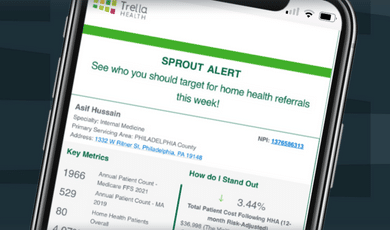BLOG
Webinar Recap: Sales Tactics for Outreach in the Digital World
By: Ashton Harrison | June 11, 2020
We recently hosted a webinar titled “Sales Tactics for Outreach in the Digital World.” On the webinar, our VP of marketing, Jess Chew, and one of our business development representatives, GiGi Moody, discussed ways for post-acute business development teams to stay engaged with referral partners using virtual resources. Trella’s business development team spends most of their time dedicated to prospecting and outreach using calls and emails, and GiGi provided insight on the importance of providing specific metrics and data to attract potential client’s attention. If you missed the webinar and would like to view the recording, it can be viewed here.
To provide you and your business development team tactical advice for maintaining outreach remotely, we are recapping the five main topics that were discussed on the webinar. We hope these tactics will allow you to continue to grow and nurture your network, even without the ability to see your referral partners in person.
Tip 1. Speak the Language– One thing that has not changed with outreach to prospects, despite all the recent changes and challenges, is the importance of researching your audience. Fully understanding your target audience is a critical first step for crafting messages that will resonate. Continuously doing your research and reading relevant news will allow you to stay informed of key terms, industry trends, as well as potential challenges. An example of this would be a home health agency that wants to build a relationship with a skilled nursing facility, and the value of understanding PDPM and the impact the reform is taking on that industry. Beginning conversations with a personal pain point will allow you to build connections. From GiGi’s perspective, one of the biggest differences between in-person and virtual outreach is the need to hook your audience as quickly as possible. In person, there is a level of pleasantries, but in the digital world, you run the risk of someone hanging up the phone or an email being ignored. To combat this, GiGi recommends the use of buzz words, such as readmission rates and ALOS.
Tip 2. Use Data to Set Yourself Apart– In GiGi’s day–to–day outreach, one of her most important tactics for engaging with prospects involves sharing personalized data and insights. She has found that specific and significant metrics solidify your value proposition and build your credibility. The more you can tell organizations about themselves, and the more research you do to make it personal, the more success you will have building that relationship. For example, if you’re a home health agency and you have a track record of being able to keep patients out of the ER, sharing your readmission rates and comparing them to your competitors would be very compelling to a hospital-based physician. Something to be aware of when it comes to data is that often, less is more. Stick to the most important points versus overwhelming your audience with too much detail. Knowing the right way to incorporate data into your messaging can be difficult, and Trella created a series of email templates that can be accessed here.
Tip 3. Understand the Data’s Relevancy– We touched on the point of using data, but to go one step farther, there is also the importance of understanding the data’s relevance in relation to the person you are speaking with. When evaluating what metrics to provide, you should first research the person’s role to best understand their priorities and challenges. From there, ask yourself, what metrics will be most valuable for this person? A VP of Finance will have very different priorities than a discharge coordinator. GiGi explained how, at Trella, we change our outreach based on the size of the agencies we are contacting. Smaller organizations receive different messaging than larger organizations because they have different needs. In addition, agencies owned by a facility receive different messaging than an independent agency. When determining what metrics to provide, it comes down to keeping it simple and strategic – identify your prospect’s pain points and use the right data to tailor your message.
Tip 4. Use Different Messaging Tactics– Without the ability to meet in person, we must utilize other channels such as calls, emails, and LinkedIn. Before making a call or sending a message, make sure you have identified what you want the outreach to accomplish. Does your organization want to schedule a meeting to speak further with this person, or do you want them to agree to something at that moment? Understanding your goal helps you keep your messaging concise and focused, as opposed to including unnecessary fluff that may cause your prospect to miss the call to action. For calls, you should be conscious of time, remain relevant, and quickly state your reasoning for reaching out. For emails, always use a strong subject line and begin the email body with the most important information. With LinkedIn, utilize relevant groups to grow your network and stay up to date on any of your connection’s accomplishments, such as a new role or promotion. Remember that everyone is having to shift their approach as well – be original, direct, and concise to help prevent your messages from getting lost in noise.
Tip 5. Be Aware of Communication Preferences– Now that we have identified outreach options, it is important to also be aware of your contact’s communication preferences. You should always tailor your outreach to your prospect’s preferred method, not your own. Some prospects may like emails, while others want a phone call. In addition, day of the week and time of day are important elements as well. Avoid calling too early; GiGi recommends nothing before 10 am, or around lunch hours when your prospect is likely heading out of the office. Coincidentally, emails are often very effective around lunchtime or early in the morning when people are drinking their coffee or in line for lunch. As for texting, this method can be very personal and should only be used if your prospect has given you permission to do so. Once you are informed of these preferences, it is important that you note them and respect them for future outreach. This will build a rapport and improve the relationship.
Tip 6. Plan Your Outreach Schedule– Our last tip is to have a strategic schedule (or cadence) for your outreach, which involves a steady, planned stream of communication. GiGi’s advice is to start gradually, then commit to an ongoing schedule. You should always be prepared to adjust your outreach schedule based on feedback and lessons learned. There are technology solutions, such as SalesLoft, which are dedicated to helping sales teams schedule their communication. Even without the access to this technology, another option is to create calendar reminders for prospect calls or emails that include notes from your previous conversation. Based on research, Jess shared that it generally takes between 6-10 touches to receive a response, which is important to keep in mind if you are becoming discouraged from lack of responsiveness. In conclusion, the scheduled outreach should prioritize relationship–building over appearing too persistent.
If your agency is looking to use more data in your outreach, there are several options. Most EMRs will highlight high–level performance metrics, such as length of stay and readmission rates, that you can start with to highlight your agency’s benefits. The Medicare compare website is a useful tool as well. If you are seeking complete data about your market, targets, and competitors, Trella’s solution has the most current and complete market data available. We recently loaded the Q4 2019 Medicare claims data into our solution, which customers can see now by logging in to Marketscape to see the updated trends. If you are not a Trella customer but are interested in learning more about Trella’s market intelligence solution, Marketscape, you can do so here.
If you have more questions regarding digital outreach, or if your team has discovered new ways to communicate with prospects, we would love to know! Join our Post-Acute Care Leadership Network on LinkedIn to share your thoughts and ideas. Trella also has additional resources, from email marketing best practices to finding success with an effective website, which can be found here.














